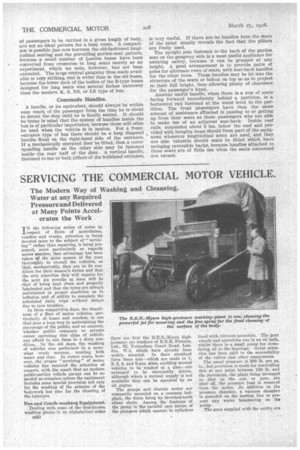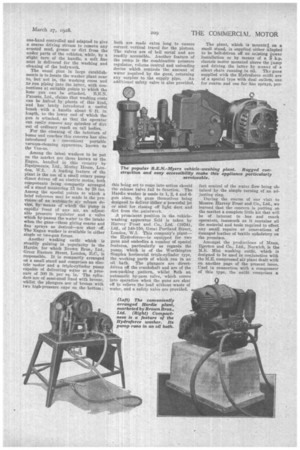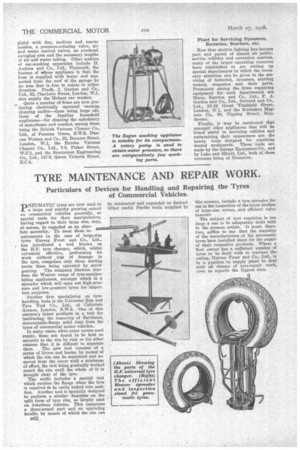SERVICING THE COMMERCIAL MOTOR VEHICLE.
Page 122

Page 123

Page 124

If you've noticed an error in this article please click here to report it so we can fix it.
The Modern Way of Washing and Cleansing. Water at any Required Pressure and Delivered at Many Points Accel erates the Work
IN the following series of notes in respect of fleets of motorbuses, coaches and trucks, attention is being devoted more to the subject of.s" servicing" rather than repairing, it being presumed, more particularly as regards motor coaches, that advantage has been taken of the quiet season of the year thoroughly to overall the vehicles, so that, mechanically, they are in fit condition for their season's duties and that the only attention they will require for the next six months at least will be -thatof being kept clean and properly lubricated and that the tyres are always maintained in proper condition as to inflation and of ability to complete the scheduled daily trips without delays due to tyre troubles.
In these competitive days, the cleanliness of a flbet of motor vehicles, particularly of buses and coaches, is one that goes a long way in maintaining the patronage of the public, and no concern, whether public company or private owner operating this class of vehicle, can afford to run them in a dirty condition. In the old days, the washing of vehicles was performed in a somewhat crude manner, wasting both water and time. In recent years, however, the proper " servicing " of motor vehicles has received the attention of • experts, with the result that no modern public-seridee vehicle garage can be regarded as complete unless the equipment includes some special provision not only for the washing of the exterior of the bodywork but also for the cleaning of the interiors.
Bus and Coach-washing Equipment. Dealing with some of the best-known washing plants in an alphabetical 'order there are first the B.E.N.-Myers highpressure car washers of B.E.N. Patents, Ltd., 92, Tottenham Court Road, London, W.1. which have already been widely adopted. In their standard form these sets—which are made in I, 2, 3, 4, and 6-gun sifts, enabling several vehicles to be washed at a time—are arranged to be electrically driven, although where a current supply is not available they can be operated by an oil engine.
The pumps and electric motor are compactly mounted on a common bedplate, the drive being by inverted-tooth silent chain. Among the features of the pump is the parallel ram action of the plungers -which operate in cylinders
lined with vitreous porcelain. The gear wheels and eccentries run in an oil bath, whilst there is a Small pump for circulating oil to the bearings. Great attention has been paid to the accessibility of the valves and other components.
The usual pressure is 300 lb, per ,sq. in., but provision is made for controlling this at any point between 150 lb. and the Maximum, the plant being -arranged so that as the gun or guns are shut off, the pressure load is removed from the motor.. in addition to the pressure chamber, a vacuum chamber is provided on the suction line to prevent any water hammering on the pump.
The guns supplied with the outfits are one-hand controlled and adapted to give a coarse driving stream to remoVe any crusted mud, grease or dirt from the under parts of the vehicles, while, by a slight turn of the handle, a soft fine mist is delivered for the washing and cleaning of the bodywork.
The usual plan in large establishments is to locate the washer plant near to, but not in, the washing room and to ran piping into the latter, with connections at suitable points to which the hose gun can be attached. B.E.N. Patents, Ltd. claims that washing costs can be halved by plants of this kind, and has lately introduced a useful brush with a handle about 6 ft. in length, to the lower end of which the gun is attached, so that the operator can easily remove any splashes of dirt Out of ordinary reach on tall bodies.
For the cleaning of the interiors of buses and coaches this concern has also introduced a convenient portable vacuum-cleaning apparatus, known as the Ven-us.
Among the latest washers to be put on the market are those known as the Eagan, handled in this country by Equipments, Ltd., Morley House, Lon
don, W.I. A leading feature of the plant is the use of a small rotary pump direct driven off an electric motor, both components being compactly arranged on a stand measuring 15 ins. by 28 ins. Among the special points to which a brief reference may be made is the provision of an automatic air release device, by means of which the pump is rapidly . freed of any air, an adjustable pressure regulator and a valve which by-passes the water to the Intake when the guns----;.these giving coarse and fine sprays as desired—are shut off. The Eagan washer is available in either single or two-gun forms.
Another washing outfit which is steadily gaining in popularity is the Hardie, for which Brown Bros., Ltd., Great Eastern Street, London, E.G., is responsible. It is compactly arranged on a small stand and comprises an electric motor and a triple-cylinder pump capable of delivering water at a pressure of 200 lb. per sq. in. The cylinders are of semi-steel lined with bronze, whilst the plungers are of bronze with two high-pressure caps on the bottom; both are made extra long to ensure correct vertical travel for the pistons. The valves are of bell metal and are readily accessible. Another feature of the pump is the combination pressure regulator, volume control and unloading device which controls the amount of water required by the guns, returning any surplus to the supply pipe. An additional safety valve is also provided, this being set to come into action should the release valve fail to function. The Hardie washer is made in I, 2, 4 and 6gun sizes, the guns themselves being designed to deliver either a powerful jet or mist for rinsing off light dust and dirt from the paintwork.
A prominent position in the .vehiclewashing apparatus field is taken by Harvey Frost and Co., Ltd. (1924), Ltd., of 148-150, Great Portland Street, London, W.1. This company's plant— the Hydroforce—is equipped for two guns and embodies a number of special features, particularly as regards the pump, which is of the Worthington Simplex horizontal triple-cylinder type, the working parts of which run in an oil bath. The plungers are directdriven off the crankshaft and are of the non-Packing pattern, whilst 'eoth an automatic by-pass valve, which comes into operation when the guns are shut off to relieve the load without waste of water, and a safety valve are provided.
The plant, which is mounte4 on a small stand) is supplied either alapted to be belt-driven off an existing tower installation or by means of a 1h.p. electric motor mounted above the g,ump and driving the latter by ir.ean3 of a silent chain running in oil. Th.* guns supplied with the Hydroforce ot.tfit are of a special type with dual outlets, one for coarse and one for fine sprays, per
feet control of the water flow being obtained by the simple turning of an adjusting ring.
During the course of our visit to MessrsHarvey Frost and Co., Ltd., we learned that the concern is putting on the market a complete little kit that will be of interest to bus and coach operators, inasmuch as it contains all the material and tools required to effect any small repairs or renovations of damaged leather of textile upholstery on the premises.
Amongst the productions of Mann, Egerton and Co., Ltd., Norwich, is the M.E. Mist washing outfit, which is designed to be used in conjunction with the M.E. compressed air plant dealt with on another page of the present issue. 'Used in connection with a compressor of this type, the outfit comprises a
pistol with fine, medium and coarse nozzles, a pressure-reducing valve, air and water control valves, an overhead swinging arm and the necessary lengths of air and water tubing. Other makers of car-washing apparatus include H. Andrew and Co., Ltd., Plymouth, the feature of whose appliance is that the hose is supplied with water and supported from the roof of the garage by an arm that is free to rotate in either direction. Fredk. J. Gordon and Co., Ltd., 92, Charlotte Street, London, W.1, also supply the Hobart car washer.
Quite a number of firms are now producing electrically operated vacuum cleaning outfits—these being large editions of the familiar household appliances—for cleaning the upholstery of motorbuses and coaches, among these being the British Vacuum Cleaner Co., Ltd., of Parsons Green, S.W.6, Duncan Watson and Co., 52, Deniers Street, London, W.1, the Eureka Vacuum Cleaner Co., Ltd., 7-8, Fisher Street, W.C.1, and the Sturtevant Engineering Co., Ltd., 147-9, Queen Victoria Street, E.C.4.
Plant for Servicing Dynamos, Batteries, Starters, etc.
Now that electric lighting has become part and parcel of almost all publicservice vehicles and excursion coaches, many of the larger operating concerns have established or are setting up special departments in which the necessary attention can be given to the servicing of batteries, dynamos, starting motors, magnetos and their parts. Prominent among the firms supplying equipment for such departments are Mann, Egerton and Co., Ltd., F. 3. Gordon and Co., Ltd., Gerrard and Co., Ltd., 15-19 Great Titelifield Street, London, W.1, and the Runbaken Magneto Co., 30, Tipping Street, Manchester.
Finally, it may be mentioned that amongst other appliances that will be found useful in servicing vehicles and maintaining their appearance are the handy tools designed for repairing dented mudguards. These tools are made by the Garage Equipment Co., and by Lake and Elliott, Ltd., both of these concerns being of Braintree.




























































































































































































